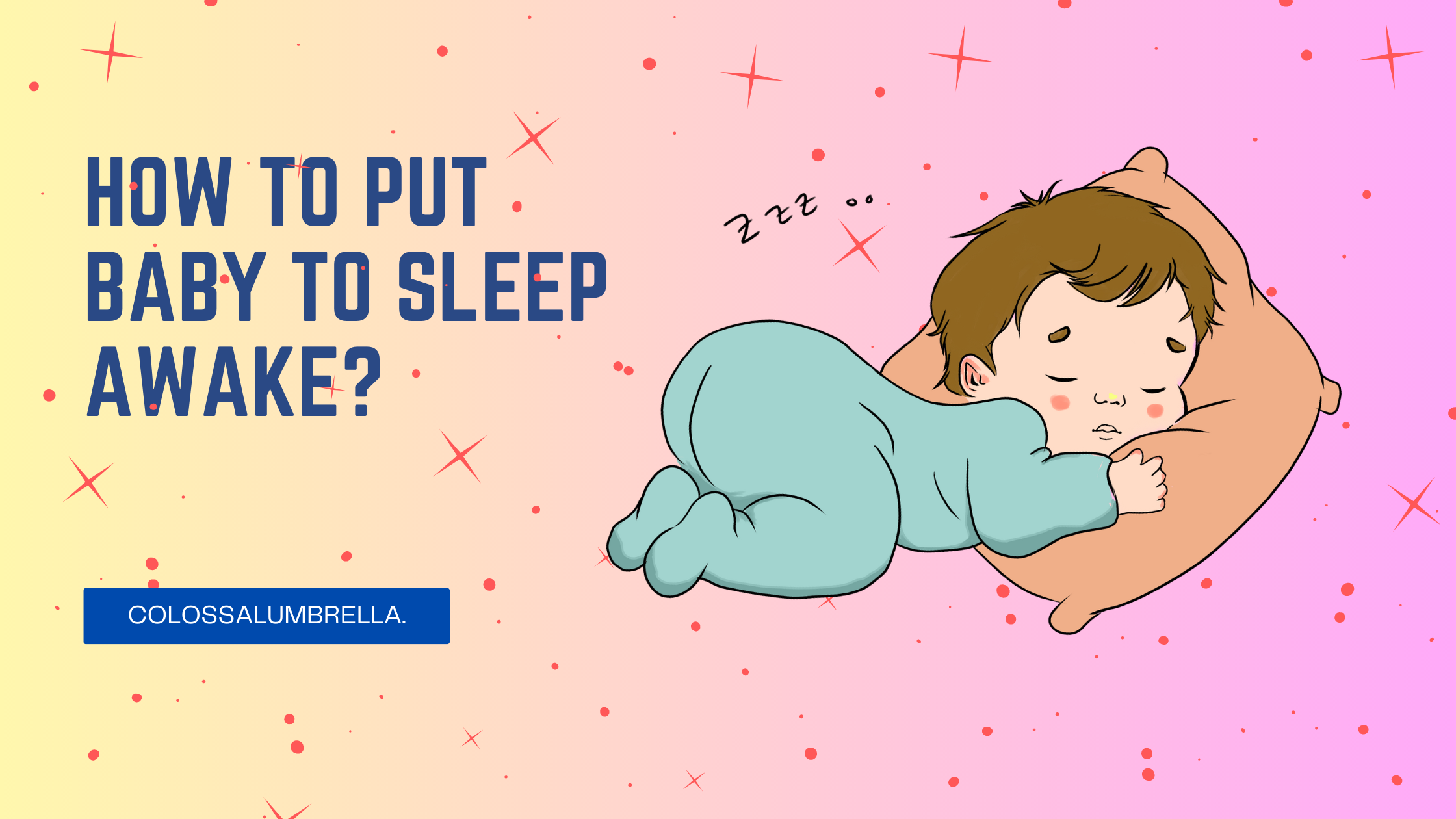Contents
How to put Baby to Sleep Awake
When my son was little, I always found it challenging to get my baby to sleep. In the first few months of age my little one would sleep only few hours and wake up frequently to feed. I would spend hours to soothe my little one until he sleeps. This can quickly become a tiresome and time-consuming routine. Most new parents experience the same situation which can make it challenging for them to get enough rest.
However, it’s essential to establish good sleep habits for your baby early on to ensure they get the rest they need to grow and develop. That’s where the technique of “putting your baby to sleep awake” comes in. This technique involves teaching your baby how to self-soothe and fall asleep on their own, without relying on being rocked to sleep. This blog post explores the benefits of this technique and ways on how to put baby to sleep awake.
What is “putting your baby to sleep awake”?
Putting your baby to sleep awake means placing them in their crib or bassinet while they are still awake and allowing them to fall asleep on their own. This technique is based on the idea that babies can learn how to self-soothe and fall asleep independently, just like adults. By teaching them this skill, they will be less likely to wake up during the night and require your help to fall back asleep.
Benefits of putting your baby to sleep awake
The benefits of putting baby to sleep awake are numerous. For babies, it helps them learn valuable self-soothing skills and promotes healthy sleep habits. It not only helps to baby sleep but also helps formulate sleep cycles and nap time. It also reduces the likelihood of them waking up during the night and needing your help to fall back asleep. For parents, it gives them more time to themselves in the evenings and reduces the stress and frustration that can come with trying to rock a baby to sleep for hours on end. Listed down are few benefits –
- Encouraging healthy sleep habits: By allowing your baby to fall asleep independently, you are helping them develop good sleep associations and habits.
- Longer stretches of sleep: Babies who know how to fall asleep on their own are less likely to wake up frequently during the night.
- Better sleep patterns: By teaching your baby to fall asleep independently, you are helping them develop their own sleep patterns and routines.
- Reduced risk of SIDS: The American Academy of Pediatrics recommends that babies be placed to sleep on their backs in a safe sleep environment, which includes a firm and flat sleep surface, a fitted sheet, and no loose bedding or soft objects. Placing your baby to sleep awake in their own crib or bassinet can reduce the risk of SIDS.

Common misconceptions on how to put baby to sleep awake
Putting your baby to sleep awake is a technique that can be effective in helping your baby develop good sleep habits, but there are some common misconceptions about it that should be addressed. Here are a few:
- It will result in your baby crying themselves to sleep: While it’s true that some babies may cry for a few minutes before falling asleep, this is not always the case. In fact, many babies are able to fall asleep without any fussing at all.
- It’s only for older babies: Putting your baby to sleep awake can be started at any age, including for newborns.
- It means abandoning your baby: This is not true. Putting your baby to sleep awake means giving them the opportunity to learn how to self-soothe and fall asleep on their own, but it doesn’t mean leaving them alone for long periods of time.
- It’s not safe: As long as you follow safe sleep guidelines, putting your baby to sleep awake is perfectly safe. This includes placing your baby on their back to sleep, in a safe and firm sleep surface, without any loose bedding, and in a room that is at a comfortable temperature.
- It’s not necessary for good sleep: While some babies may be able to fall asleep easily without being put to sleep awake, many babies benefit from learning how to fall asleep independently. This can lead to longer stretches of sleep and a more consistent sleep routine.
Tips for putting your baby to sleep awake
Putting your baby to sleep awake can be a good idea to encourage independent sleep, especially for newborn babies. However, it’s important to note that young infants have shorter sleep cycles and spend more time in light sleep compared to adults, so it may take some time for them to learn how to fall asleep on their own. Here are some tips for putting baby to sleep awake
- Establish a soothing bedtime routine: It is a good idea to create soothing bedtime routine that can help signal to newborn babies that it’s time for sleep. This can include a warm bath, a gentle massage, diaper change, a lullaby, or some quiet time with a book.
- Use white noise or soft music: Soft background noise can be soothing for babies and help drown out any external noises that may disturb their sleep. This is best way to help you baby fall into light sleep.
- Make sure your baby is comfortable: Ensure that your baby’s sleep environment is safe, comfortable, and conducive to sleep. This includes a comfortable temperature, a safe sleep space, and loose-fitting clothing. It’s a good idea to change your baby’s diaper before putting them to sleep to ensure their comfort.
- Look for sleep cues: Recognize your baby’s sleep cues such as eye rubbing, yawning, or fussing. These can signal that your baby is tired and ready for sleep. It is important to work on creating a baby’ sleep pattern during early months of life.
- Create a sleep-friendly atmosphere: Dim the lights, close the curtains, and minimize any other distractions that may keep your baby from settling into a sleepy state.
- Stick to a schedule: Consistency is key when it comes to helping your baby establish good sleep habits. Try to stick to a consistent sleep schedule that allows for the recommended hours of sleep based on your baby’s age.
- Give your baby time to fall asleep: After placing your baby in their crib or bassinet, give them some time to fall asleep on their own. It’s normal for babies to fuss or cry for a few minutes before settling down. During the 24-hour period, it’s common for babies to have night wakings and nighttime feedings, especially in the middle of the night when their internal clocks may be disrupted. Baby naps are also important for their development, and it’s essential to pay attention to their sleep cues and establish a soothing routine that works for them.
How to handle setbacks and challenges
Teaching your baby to fall asleep on their own can sometimes be challenging. Here are some tips for handling setbacks and challenges:
- Be patient. Learning this skill takes time, so it’s important to be patient and avoid becoming frustrated.
- Adjust your approach if needed. If a particular technique isn’t working, it’s okay to try something different.
- Seek support. Don’t be afraid to reach out to a healthcare professional or sleep consultant for support and guidance.
Conclusion
Putting a baby to sleep while they are still awake is not always an easy task. However, by following some of the tips and strategies we have discussed, such as establishing a routine, creating a soothing environment, and understanding the baby’s sleep patterns, parents can help their little ones develop healthy sleeping habits. Remember, every baby is unique, and what works for one may not work for another. Be patient, stay consistent, and always prioritize the safety and comfort of your baby. With time, you will find a routine that works best for your family and helps your baby get the restful sleep they need to thrive.
I would stay connected and keep you updated with parenting tips, pregnancy guides, creative ideas, easy crafts, and Free Printables. Subscribe to Colossalumbrella to get new ideas delivered to your inbox. Follow me on Facebook, Pinterest, Twitter, and Instagram.
Shop
I would appreciate you support to help me run this blog. I run a small affiliate shop, which means that if you click on the link and make a purchase, I may earn a commission at no additional cost to you.
Disclaimer: The content of this blog is for informational purposes only and is not intended to be a substitute for professional medical advice, diagnosis, or treatment. Always seek the advice of your physician or other qualified healthcare providers with any questions you may have regarding a medical condition.

3 thoughts on “7 Effective Tips on How to Put Baby to Sleep Awake”
Comments are closed.